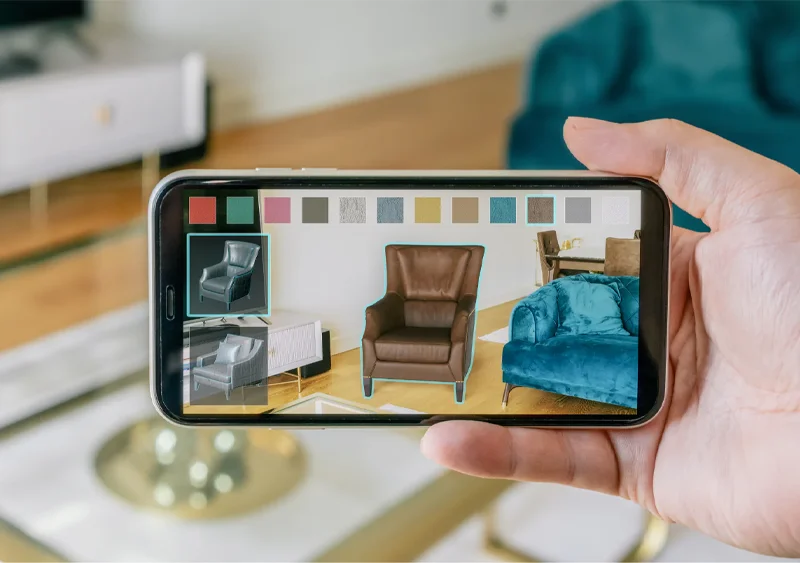Explore, Interact, Buy: How 3D is Transforming the Online Shopping Experience
The 3D solution every online retailer needs to stay ahead of competition

6 MIN READ
January 13, 2025

Written By
Allwyn Ruban
Static product images are no longer enough to engage modern online shoppers. The lack of interactivity and realism often leads to hesitation, lower conversions, and increased returns. For eCommerce businesses, 3D for eCommerce is redefining how products are presented, creating more clarity and trust in the buyer’s journey.
The Shift Toward 3D in eCommerce
Online shopping has come a long way. Early websites relied on basic product photos and written descriptions, but these don’t always provide the clarity customers need. Today, 3D product displays offer an immersive experience that bridges the gap between physical and online shopping.
With 3D for eCommerce, customers can zoom, rotate, and interact with products as if they were holding them in their hands. This interactivity builds confidence and reduces doubts, which is especially crucial for high-value or complex items like furniture, electronics, or luxury goods.
-
Key Statistics
- According to a Shopify study, products with 3D or AR experiences see a 94% higher conversion rate.
- Nearly 84% of online shoppers say personalization influences their purchases
- Businesses using 3D models report a 40% reduction in product returns.
Clearly, the numbers show the growing importance of 3D for eCommerce.
Top 4 Benefits of 3D Product Displays for eCommerce
1. Enhanced Customer Experience
3D displays create a dynamic shopping experience. Instead of squinting at flat images, shoppers can view products from every angle, zoom in on details, and even customize colors or features. This gives them a better understanding of what they’re buying.
For example, a customer shopping for a sofa can explore its dimensions, see how it fits in a virtual living room, or check the texture of the fabric. This hands-on feel makes online shopping more engaging and fun.
2. Increased Purchase Confidence
One of the biggest challenges in eCommerce is the "what if" factor. Shoppers often hesitate because they’re unsure about a product’s size, quality, or actual appearance. 3D for eCommerce eliminates these doubts by offering a near-real-life representation of the product.
When customers can see a product as it truly is, they’re more likely to hit the “Buy Now” button.
3. Fewer Returns and Refunds
Returns are a headache for any eCommerce business. They’re costly, time-consuming, and impact profit margins. Many returns happen because the product doesn’t match the customer’s expectations.
With 3D for eCommerce, shoppers know exactly what to expect. This transparency reduces misunderstandings and drastically cuts down on return rates.
4. Competitive Edge
Standing out in a crowded eCommerce market is tough. Offering 3D product displays sets your store apart, showing that your brand is forward-thinking and customer-focused. It’s an investment that not only attracts more customers but also builds trust and loyalty.
Looking for 3D Models for eCommerce? Partner with the World-Class 3D Design Studio for cutting-edge solutions.
How 3D Product Displays Work?
You might be wondering how these 3D models are created and implemented. Here’s a quick breakdown:

-
1. Scanning or Modeling
- Products can be scanned using advanced 3D scanners, or designers can create models from scratch using specialized software like Blender or Maya.
-
2. Integration with eCommerce Platforms
- Once the 3D models are ready, they’re integrated into the eCommerce site using tools compatible with platforms like Shopify, WooCommerce, or Magento.
-
3. Interactive Features
- Features like zoom, rotate, and augmented reality (AR) are added to let customers interact with the product in real-time. For example, AR allows shoppers to see how a product looks in their environment using their smartphone camera.
Real-Life Applications of 3D for eCommerce
-
Fashion and Apparel
Virtual try-ons are revolutionizing how people shop for clothes and accessories. Using 3D models, customers can see how a dress fits or how a pair of sunglasses suits their face. -
Furniture and Home Décor
Ever bought furniture online, only to find it doesn’t fit your space? 3D for eCommerce solves this problem with tools that allow customers to place virtual furniture in their rooms before buying. -
Electronics
Detailed 3D models help shoppers explore the design, ports, and features of gadgets like laptops, smartphones, and cameras. -
Automotive
Starting from car interiors to engine details, 3D displays are making it easier for buyers to explore vehicles online without visiting a showroom.
Challenges in Implementing 3D for eCommerce
While the benefits are undeniable, implementing 3D technology isn’t without challenges:
- Creating high-quality 3D models can be expensive. However, the return on investment often outweighs the upfront costs.
- Building and integrating 3D models require skilled designers and developers. Many businesses partner with specialized agencies to overcome this hurdle.
- 3D content is data-heavy and can slow down website performance if not optimized properly. Using tools like WebGL and efficient compression techniques can help maintain speed.
The Future of 3D for eCommerce
The adoption of 3D for eCommerce is still growing, but it’s clear that it’s here to stay. As technology advances, we’ll see even more immersive experiences, such as:
- Virtual Reality (VR) Shopping: Customers could step into a virtual store, pick up items, and check out, all from the comfort of their home.
- Personalized 3D Experiences: AI-driven 3D customization could allow shoppers to create unique versions of products tailored to their needs.
- Seamless Mobile Integration: As mobile shopping grows, 3D and AR features will become standard on smartphones.
Why Your eCommerce Site Needs 3D Displays Today?
If your business hasn’t yet embraced 3D for eCommerce, now is the time. Customers are no longer satisfied with static images; they want interactive, realistic experiences that mimic in-store shopping. Investing in 3D technology not only enhances customer satisfaction but also boosts sales and reduces returns.
In a space where first impressions matter, 3D product displays ensure your brand stands out. The question isn’t whether you should adopt this technology. It’s how soon you can make it happen.
Outsource 3D modeling services today and revolutionize your online retail strategy with realistic and interactive product visuals.
About the writer :
Allwyn Ruban heads business development and marketing at Zealous Services. He’s the go-to person for finding smart ... ways to grow their 3D services, from animation to modeling. With a knack for digital strategy, Allwyn is all about helping clients achieve their goals while expanding Zealous' reach in the industry. His friendly approach makes collaboration easy and effective.
Read MoreFrequently Asked Questions (FAQ)
What industries benefit the most from 3D product displays in eCommerce?
3D product displays are highly effective for industries like fashion, furniture, electronics, automotive, and luxury goods. These sectors rely on detailed visuals to showcase complex products, allowing customers to make informed decisions without physical interaction.
How does 3D technology impact eCommerce SEO performance?
3D technology enhances SEO by increasing user engagement and dwell time on your website. Interactive content is favored by search engines, and the reduced return rates lead to better customer reviews, indirectly boosting SEO rankings.
Can small eCommerce businesses afford 3D product displays?
Yes, the cost of implementing 3D for eCommerce has decreased over the years, with scalable solutions available. Cloud-based tools and third-party services make it accessible for small businesses without requiring significant investments.
Are 3D product displays compatible with mobile devices?
Most 3D solutions are optimized for mobile platforms, allowing customers to interact with products seamlessly. Technologies like WebGL ensure compatibility across devices without compromising speed or performance.
What data insights can businesses gain from 3D product displays?
3D product displays allow businesses to track customer interactions, such as rotation, zoom, and customization preferences. These insights help in understanding buyer behavior and improving product presentation strategies.